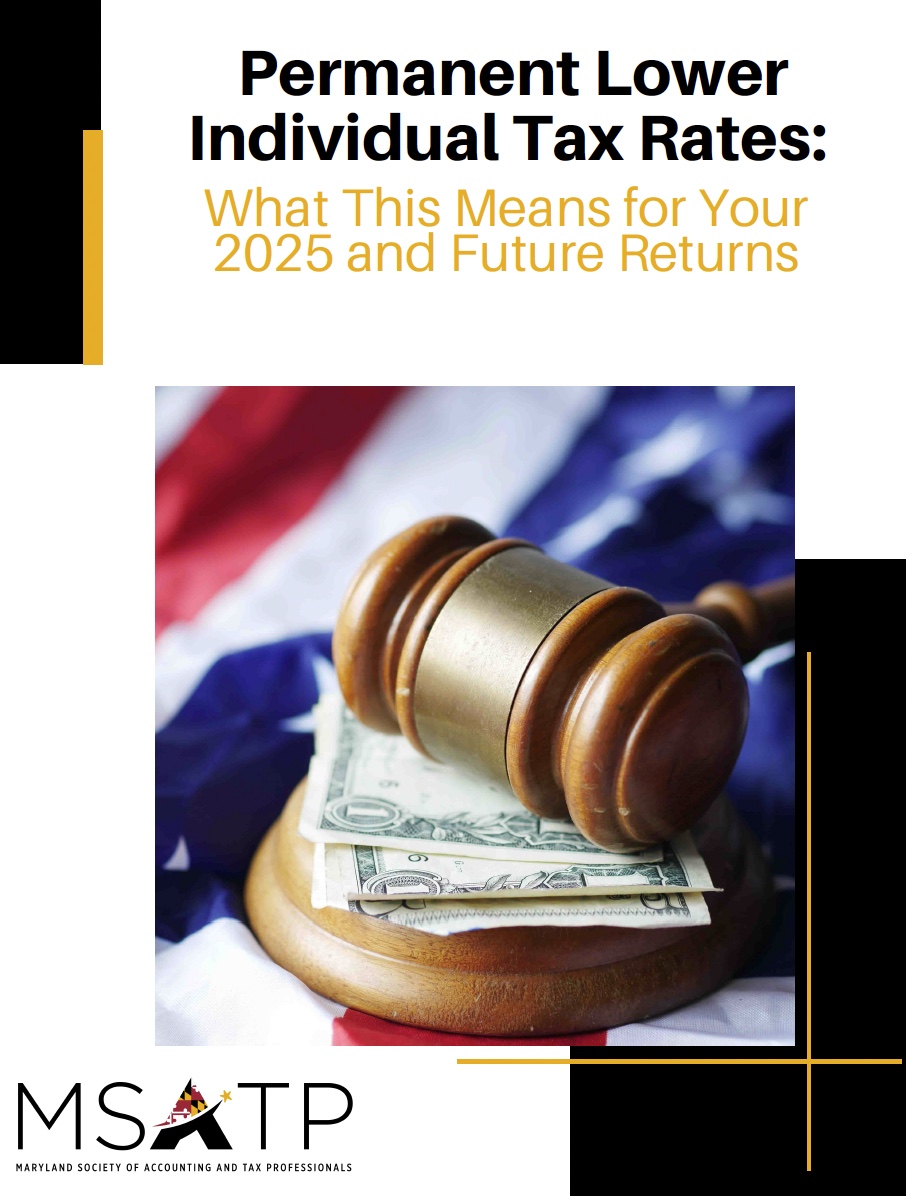
As your trusted partner, MSATP is here to help you guide your clients through the permanent extension of lower individual tax rates under the One Big Beautiful Bill Act (OBBBA). We’ve distilled the most important legal updates into client‑friendly language, provided proven messaging frameworks, and assembled practical, step‑by‑step tips you can use today—so you can confidently explain what’s changed, why it matters, and exactly how they can take advantage of the new rates. Download the Resource Here
1. Legal Explanation: Permanent Extension of Lower Individual Tax Rates
Background:
-
The Tax Cuts and Jobs Act (TCJA) of 2017 temporarily reduced individual income tax rates and expanded the tax brackets for most taxpayers, but these provisions were set to expire after 2025, reverting to higher pre-2018 rates.
-
The OBBBA (H.R. 1, 2025) makes these lower rates permanent for tax years after 2025 by amending IRC §1(j) to remove the expiration date and maintain the TCJA-era rate structure indefinitely.
How the Tax Brackets Work Post-2025:
-
The OBBBA preserves the seven-bracket structure and the lower marginal rates (10%, 12%, 22%, 24%, 32%, 35%, 37%) that were introduced by the TCJA.
-
The income thresholds for each bracket continue to be adjusted annually for inflation, as under prior law.
-
For example, for married filing jointly in 2025, the brackets are as follows (rounded for illustration; actual thresholds are inflation-adjusted annually):
Taxable Income (Married Filing Jointly)
Marginal Rate
Up to ~$19,050
10%
$19,051 – $77,400
12%
$77,401 – $165,000
22%
$165,001 – $315,000
24%
$315,001 – $400,000
32%
$400,001 – $600,000
35%
Over $600,000
37%
(Thresholds for other filing statuses are similarly structured and adjusted for inflation).
-
The OBBBA also makes permanent the increased standard deduction and other related provisions, further reducing taxable income for many filers.
2. Guidance and Messaging Strategies for Client Communications
A. Emphasize Permanence and Certainty
-
Key Message: “The lower individual tax rates you’ve benefited from since 2018 are now permanent under the new law. This means you can plan with greater certainty, knowing that the lower rates and expanded brackets will not expire after 2025.”
-
Why It Matters: Clients may have heard that rates were set to increase after 2025. Reassure them that this risk has been eliminated.
B. Explain the Bracket Structure and Its Impact
-
Key Message: “The seven-bracket system and lower rates remain in place, so your tax liability will continue to be calculated using the same structure as in recent years. The income thresholds for each bracket will keep pace with inflation.”
-
Practical Tip: Use client-specific examples to show how their income fits into the brackets and what their marginal and effective tax rates are likely to be.
C. Highlight Related Permanent Provisions
-
Key Message: “In addition to lower rates, the higher standard deduction and other favorable provisions are now permanent, which can further reduce your taxable income and overall tax bill.”
-
Practical Tip: Review whether clients should continue to itemize or take the standard deduction, as the higher standard deduction may make itemizing less beneficial for many.
D. Address Planning Opportunities
-
Key Message: “With the certainty of lower rates, now is a good time to revisit your long-term tax planning strategies.”
-
Planning Tips:
-
Income Acceleration/Deferral: With rates stable, there is less urgency to accelerate income or defer deductions in anticipation of higher future rates.
-
Roth Conversions: Lower rates may make Roth IRA conversions more attractive, as the tax cost of conversion is lower.
-
Charitable Giving: The higher standard deduction means fewer people itemize, but above-the-line charitable deductions and new floors for itemized deductions may affect giving strategies.
-
Estate Planning: The permanently increased estate and gift tax exemption (now $15 million, indexed for inflation) offers significant opportunities for wealth transfer planning.
-
Business Owners: The Section 199A qualified business income deduction is also made permanent and enhanced, which is important for pass-through business owners.
-
E. Prepare for Future Adjustments
-
Key Message: “While these changes are permanent under current law, future Congresses can always make further changes. We will continue to monitor developments and advise you accordingly.”
-
Practical Tip: Encourage clients to schedule annual tax planning reviews to adapt to any future legislative changes.
3. Practical Tips for Tax Professionals
-
Use Visual Aids: Provide clients with updated tax rate tables and side-by-side comparisons of pre- and post-OBBBA brackets.
-
Personalize the Impact: Run projections using the client’s actual or estimated income to show the effect of the permanent rates on their tax liability.
-
Proactive Outreach: Send newsletters or host webinars summarizing the key changes and inviting clients to discuss their specific situations.
-
Address Common Questions:
-
“Will my taxes go up after 2025?” (Answer: Not due to rate increases; the lower rates are now permanent.)
-
“Should I change my withholding or estimated payments?” (Answer: Possibly, if your situation has changed, but not solely due to rate changes.)
-
“Does this affect my retirement or estate planning?” (Answer: Yes, the permanence of lower rates and higher exemptions may open new planning opportunities.)
-
4. Summary Table for Client Handouts (Optional for Internal Use)
Provision |
Pre-2026 Law (TCJA) |
OBBBA (Post-2025) |
|---|---|---|
Individual Tax Rates |
Lower rates, expire 2025 |
Lower rates, permanent |
Standard Deduction |
Higher, expires 2025 |
Higher, permanent |
Estate/Gift Exemption |
~$13M, expires 2025 |
$15M, permanent |
QBI Deduction (199A) |
Expires 2025 |
Permanent, enhanced |
5. References for Further Reading
-
Internal Revenue Code §1(j) as amended by OBBBA
-
OBBBA Section 70101 and summary tables
-
IRS inflation-adjusted tax tables
